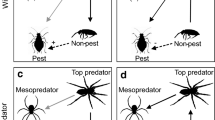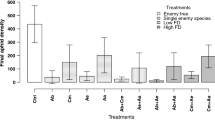Abstract
Biocontrol with predators is a key tool for controlling agricultural pests and preserving the productive efficiency of crops. Determining which predators to use for biocontrol often involves measuring their functional response—the relationship between foraging rate and prey abundance, yet comparisons of functional responses across predators are complicated by differences in experimental procedures. Here we use a compilation of functional responses standardized for time and space units to illustrate key sources of variation in functional responses for predators being tested for control of aphids and mites. Our results show that arena size (as a proxy for habitat structure) is a crucial predictor of predator performance, indicating that assessments of functional responses on the crops of interest may be necessary for accurate comparisons. Our results also suggest that larger predators may generally be more efficient, and that warming linked to climate change could make biocontrol using predators more effective when pests are abundant.





Similar content being viewed by others
Data availability
All data are publicly available online.
Code availability
Our code is available upon request and we plan to post it to FigShare.
References
Alexander ME, Kaiser H, Weyl OLF, Dick JTA (2015) Habitat simplification increases the impact of a freshwater invasive fish. Environ Biol Fish 98:477–486
Amarasekare P (2015) Effects of temperature on consumer–resource interactions. J Anim Ecol 84:665–679
Anwer A (ed) (2017) Biopesticides and bioagents: novel tools for pest management. Apple Academic Press, Boca Raton
Barrios-O’Neill D, Dick JTA, Emmerson MC, Ricciardi A, MacIsaac HJ (2015) Predator-free space, functional responses and biological invasions. Funct Ecol 29:377–384
Bebber DP, Ramotowski MAT, Gurr SJ (2013) Crop pests and pathogens move polewards in a warming world. Nat Clim Change 3:985–988
Bergström U, Englund G (2004) Spatial scale, heterogeneity and functional responses. J Anim Ecol 73:487–493
Blackman RL, Eastop VF (2000) Aphids on the world’s crops: an identification and information guide. Wiley, Hoboken
Brown J, Gillooly J, Allen A, Savage VM, West GB (2004) Toward a metabolic theory of ecology. Ecology 85:1771–1789
Bruce TJA (2010) Tackling the threat to food security caused by crop pests in the new millennium. Food Secur 2:133–141
Burnside WR, Erhardt EB, Hammond ST, Brown JH (2014) Rates of biotic interactions scale predictably with temperature despite variation. Oikos 123:1449–1456
Calvo FJ, Knapp M, van Houten YM, Hoogerbrugge H, Belda JE (2015) Amblyseius swirskii: what made this predatory mite such a successful biocontrol agent? Exp Appl Acarol 65:419–433
Clausen CP (1978) Introduced parasites and predators of arthropod pests and weeds: a world review. Agricultural handbook number 480. U.S. Department of Agriculture, New York
Costanza R, d’Arge R, de Groot R, Fraber S, Grasso M, Hannon B, Limburg K, Naeem S, O’Neill RV, Paruelo J, Raskin RG, Sutton P, van den Belt M (1997) The value of the world’s ecosystem services and natural capital. Nature 387:253–260
Cuthbert RN, Dalu T, Wasserman RJ, Callaghan A, Weyl OLF, Dick JTA (2019) Using functional responses to quantify notonectid predatory impacts across increasingly complex environments. Acta Oecol 95:116–119
de Brooke ML, Hanley S, Laughlin SB (1999) The scaling of eye size with body mass in birds. Proc R Soc Lond B Biol Sci 266:405–412
DeLong JP (2021) Predator ecology: the evolutionary ecology of the functional response. Oxford University Press
DeLong JP, Vasseur DA (2012) A dynamic explanation of size-density scaling in carnivores. Ecology 93:470–476
Devictor V, van Swaay C, Brereton T, Brotons L, Chamberlain D, Heliölä J, Herrando S, Julliard R, Kuussaari M, Lindström Å, Reif J, Roy DB, Schweiger O, Settele J, Stefanescu C, van Strien A, van Turnhout C, Vermouzek Z, WallisDeVries M, Wynhoff I, Jiguet F (2012) Differences in the climatic debts of birds and butterflies at a continental scale. Nat Clim Change 2:121–124
Ding-Xu L, Juan T, Zuo-Rui S (2007) Functional response of the predator Scolothrips takahashii to hawthorn spider mite, Tetranychus viennensis: effect of age and temperature. BioControl 52:41–61
Englund G, Öhlund G, Hein CL, Diehl S (2011) Temperature dependence of the functional response. Ecol Lett 14:914–921
Fletcher NH (2004) A simple frequency-scaling rule for animal communication. J Acoust Soc Am 115:2334–2338
Forster J, Hirst AG, Atkinson D (2012) Warming-induced reductions in body size are greater in aquatic than terrestrial species. Proc Natl Acad Sci 109:19310–19314
Gergs A, Ratte HT (2009) Predicting functional response and size selectivity of juvenile Notonecta maculata foraging on Daphnia magna. Ecol Model 220:3331–3341
Gilbert B, Tunney TD, McCann KS, DeLong JP, Vasseur DA, Savage V, Shurin JB, Dell AI, Barton BT, Harley CDG, Kharouba HM, Kratina P, Blanchard JL, Clements C, Winder M, Greig HS, O’Connor MI (2014) A bioenergetic framework for the temperature dependence of trophic interactions. Ecol Lett 17:902–914
Ho C-C (2000) Spider-mite problems and control in Taiwan. Exp Appl Acarol 24:453–462
Hoddle MS (2003) The effect of prey species and environmental complexity on the functional response of Franklinothrips Orizabensis: a test of the fractal foraging model. Ecol. Entomol. 28:309–318
Holling CS (1959) The components of predation as revealed by a study of small-mammal predation of the European pine sawfly. Can Entomol 91:293–320
Hullé M, Cœur d’Acier A, Bankhead-Dronnet S, Harrington R (2010) Aphids in the face of global changes. Comp Rend Biol 333:497–503
Islam Y, Shah FM, Shah MA, Khan MM, Rasheed MA, Rehman SU, Ali S, Zhou X (2020) Temperature-dependent functional response of Harmonia axyridis (Coleoptera: Coccinellidae) on the eggs of Spodoptera litura (Lepidoptera: Noctuidae) in laboratory. Insects 11:583
Islam Y, Shah FM, Rubing X, Razag M, Yabo M, Xihong L, Zhou X (2021) Functional response of Harmonia axyridis preying on Acyrthosiphon pisum nymphs: the effect of temperature. Sci Rep 11:13565
Jeppson LR, Keifer HH, Baker EW (1975) Mites injurious to economic plants. University of California Press
Kalinoski RM, DeLong JP (2016) Beyond body mass: how prey traits improve predictions of functional response parameters. Oecologia 180:543–550
Kiørboe T, Thomas MK (2020) Heterotrophic eukaryotes show a slow-fast continuum, not a gleaner–exploiter trade-off. Proc Natl Acad Sci 117:24893–24899
Koski ML, Johnson BM (2002) Functional response of kokanee salmon (Oncorhynchus nerka) to Daphnia at different light levels. Can J Fish Aquat Sci 59:707–716
Kreuzinger-Janik B, Hüttemann HB, Traunspurger W (2019) Effect of prey size and structural complexity on the functional response in a nematode–nematode system. Sci Rep 9:5696
Kumar B, Omkar (2018) Insect pest management. In: Omkar (ed) Pests and their management. Springer, Singapore, pp 1015–1078
Kundoo AA, Khan A (2017) Coccinellids as biological control agents of soft bodied insects: a review. J Entomol Zool Stud 5:1362–1373
Lang B, Rall BC, Brose U (2012) Warming effects on consumption and intraspecific interference competition depend on predator metabolism. J Anim Ecol 81:516–523
Lehmann P, Ammunét T, Barton M, Battisti A, Eigenbrode SD, Jepsen JU, Kalinkat G, Neuvonen S, Niemelä P, Terblanche JS, Økland B, Björkman C (2020) Complex responses of global insect pests to climate warming. Front Ecol Environ 18:141–150
McGill BJ, Mittelbach GC (2006) An allometric vision and motion model to predict prey encounter rates. Evol Ecol Res 8:691–701
Memmott J, Martinez ND, Cohen JE (2000) Predators, parasitoids and pathogens: species richness, trophic generality and body sizes in a natural food web. J Anim Ecol 69:1–15
Messina FJ, Hanks JB (1998) Host plant alters the shape of the functional response of an aphid predator (Coleoptera: Coccinellidae). Environ Entomol 27:1196–1202
Naranjo SE, Ellsworth PC, Frisvold GB (2015) Economic value of biological control in integrated pest management of managed plant systems. Annu Rev Entomol 60:621–645
Naranjo S, Frisvold G, Ellsworth PC (2019) Economic value of arthropod biological control. In: Onstad DW, Crain P (eds) The economics of integrated pest management of insects. CABI, Wallingford, pp 49–85
Neuenschwander P, Borgemeister C, Langewald J (2003) Biological control in IPM systems in Africa. CABI, Wallingford
Oerke E-C (2006) Crop losses to pests. J Agric Sci 144:31–43
Parmesan C, Yohe G (2003) A globally coherent fingerprint of climate change impacts across natural systems. Nature 421:37–42
Rall BC, Brose U, Hartvig M, Kalinkat G, Schwarzmüller F, Vucic-Pestic O, Petchey OL (2012) Universal temperature and body-mass scaling of feeding rates. Philos Trans R Soc B Biol Sci 367:2923–2934
Roy S, Muraleedharan N, Mukhopadhyay A (2014) The red spider mite, Oligonychus coffeae (Acari: Tetranychidae): its status, biology, ecology and management in tea plantations. Exp Appl Acarol 63:431–463
Singh K (2014) Biocontrol: an overview. Int J Sci Innov Res 2:83–89
Singh R, Singh G (2016) Aphids and their biocontrol. In: Omkar (ed) Ecofriendly pest management for food security. Academic Press, San Diego, pp 63–108
Skendžić S, Zovko M, Živković IP, Lešić V, Lemić D (2021) The impact of climate change on agricultural insect pests. Insects 12:440
Solomon ME (1949) The natural control of animal populations. J Anim Ecol 18:1–35
Song YH, Heong KL (1997) Changes in searching responses with temperature of Cyrtorhinus lividipennis reuter (Hemiptera: Miridae) on the eggs of the brown planthopper, Nilaparvata lugens (Stål.) (Homoptera: Delphacidae). Popul Ecol 39:201–206
Stiling P, Cornelissen T (2005) What makes a successful biocontrol agent? A meta-analysis of biological control agent performance. Biol Control 34:236–246
Symondson WOC, Sunderland KD, Greenstone MH (2002) Can generalist predators be effective biocontrol agents? Annu Rev Entomol 47:561–594
Thompson DJ (1978) Towards a realistic predator-prey model: the effect of temperature on the functional response and life history of larvae of the damselfly, Ischnura elegans. J Anim Ecol 47:757–767
Uiterwaal SF, DeLong JP (2018) Multiple factors, including arena size, shape the functional responses of ladybird beetles. J Appl Ecol 55:2429–2438
Uiterwaal SF, DeLong JP (2020) Functional responses are maximized at intermediate temperatures. Ecology 101:e02975
Uiterwaal SF, Lagerstrom IT, Lyon SR, DeLong JP (2018) Data paper: FoRAGE (functional responses from around the globe in all ecosystems) database: a compilation of functional responses for consumers and parasitoids. BioRxiv. https://doi.org/10.1101/503334
Uiterwaal SF, Dell AI, DeLong JP (2019) Arena size modulates functional responses via behavioral mechanisms. Behav Ecol 30:483–489
Uszko W, Diehl S, Englund G, Amarasekare P (2017) Effects of warming on predator–prey interactions—a resource-based approach and a theoretical synthesis. Ecol Lett 20:513–523
van Emden HF, Harrington R (2017) Aphids as crop pests. CABI, Wallingford
van Lenteren JC (2012) The state of commercial augmentative biological control: plenty of natural enemies, but a frustrating lack of uptake. BioControl 57:1–20
van Lenteren JC, Bolckmans K, Köhl J, Ravensberg WJ, Urbaneja A (2018) Biological control using invertebrates and microorganisms: plenty of new opportunities. BioControl 63:39–59
Vucic-Pestic O, Rall BC, Kalinkat G, Brose U (2010) Allometric functional response model: body masses constrain interaction strengths. J Anim Ecol 79:249–256
Ware DM (1972) Predation by rainbow trout (Salmo gairdneri): the influence of hunger, prey density, and prey size. J Fish Res Board Can 29:1193–1201
Acknowledgements
This work was supported by a National Science Foundation Graduate Research Fellowship to SFU and by a James S. McDonnell Foundation Studying Complex Systems Scholar Award to JPD.
Funding
This work was supported by a National Science Foundation Graduate Research Fellowship (DGE-1610400) and a James S. McDonnell Foundation Studying Complex Systems Scholar Award.
Author information
Authors and Affiliations
Contributions
Both authors conceived of the work, contributed to analysis, and wrote and edited the paper.
Corresponding author
Ethics declarations
Conflict of interest
The authors declare that they have no conflict of interest.
Ethical approval
Not applicable.
Research involving humans and/or animals
Not applicable.
Consent to participate
Not applicable.
Consent for publication
Not applicable.
Additional information
Handling Editor: Marta Montserrat.
Rights and permissions
About this article
Cite this article
DeLong, J.P., Uiterwaal, S.F. Predator functional responses and the biocontrol of aphids and mites. BioControl 67, 161–172 (2022). https://doi.org/10.1007/s10526-021-10127-1
Received:
Accepted:
Published:
Issue Date:
DOI: https://doi.org/10.1007/s10526-021-10127-1




